Highly Selective and Sensitive Sensor Based IL and CMC-MWCNTs Nanocomposite for Rutin Determination
Abstract
1. Introduction
2. Materials and Methods
2.1. Reagents and Materials
2.2. Apparatus and Measurements
2.3. Electrode Preparation and Modification
2.4. Real-Sample Preparation
3. Results and Discussion
3.1. Characteristics of Nanomaterials
3.2. Electrochemical Characterization of Nanomaterial-Modified GCEs
3.3. Effects of Scan Rates
3.4. Different Methods of Rutin Measurement
3.5. Effects of pH Values
3.6. Precision Detection of Rutin
3.7. Anti-Interference Ability and Stability of the Modified Electrode
3.8. Real-Sample Determination of Rutin in Tablets
4. Conclusions
Author Contributions
Funding
Institutional Review Board Statement
Informed Consent Statement
Data Availability Statement
Acknowledgments
Conflicts of Interest
References
- Enogieru, A.B.; Haylett, W.; Hiss, D.C.; Bardien, S.; Ekpo, O.E. Rutin as a Potent Antioxidant: Implications for Neurodegenerative Disorders. Oxidative Med. Cell. Longev. 2018, 2018, 6241017. [Google Scholar] [CrossRef] [PubMed]
- Fabjan, N.; Rode, J.; Košir, I.J.; Wang, Z.; Zhang, Z.; Kreft, I. Tartary Buckwheat (Fagopyrum tataricum Gaertn.) as a Source of Dietary Rutin and Quercitrin. J. Agric. Food Chem. 2003, 5122, 6452–6455. [Google Scholar] [CrossRef] [PubMed]
- Ganeshpurkar, A.; Saluja, A.K. The Pharmacological Potential of Rutin. Saudi Pharm. J. 2017, 252, 149–164. [Google Scholar] [CrossRef] [PubMed]
- Wang, C.; Wang, Q.; Zhong, M.; Kan, X. Boronic acid based imprinted electrochemical sensor for rutin recognition and detection. Analyst 2016, 14120, 5792–5798. [Google Scholar] [CrossRef]
- Sharma, S.; Ali, A.; Ali, J.; Sahni, J.K.; Baboota, S. Rutin: Therapeutic potential and recent advances in drug delivery. Expert Opin. Investig. Drugs 2013, 228, 1063–1079. [Google Scholar] [CrossRef] [PubMed]
- Chua, L.S. A review on plant-based rutin extraction methods and its pharmacological activities. J. Ethnopharmacol. 2013, 1503, 805–817. [Google Scholar] [CrossRef]
- Ghorbani, A. Mechanisms of antidiabetic effects of flavonoid rutin. Biomed. Pharmacother. 2017, 96, 305–312. [Google Scholar] [CrossRef]
- Gullón, B.; Lú-Chau, T.A.; Moreira, M.T.; Lema, J.M.; Eibes, G. Rutin: A review on extraction, identification and purification methods, biological activities and approaches to enhance its bioavailability. Trends Food Sci. Technol. 2017, 67, 220–235. [Google Scholar] [CrossRef]
- Imani, A.; Maleki, N.; Bohlouli, S.; Kouhsoltani, M.; Sharifi, S.; Dizaj, S.M. Molecular mechanisms of anticancer effect of rutin. Phytother. Res. 2021, 355, 2500–2513. [Google Scholar] [CrossRef]
- Hosseinzadeh, H.; Nassiri-Asl, M. Review of the protective effects of rutin on the metabolic function as an important dietary flavonoid. J. Endocrinol. Investig. 2014, 379, 783–788. [Google Scholar] [CrossRef] [PubMed]
- Choi, S.-S.; Park, H.-R.; Lee, K.-A. A comparative study of rutin and rutin glycoside: Antioxidant activity, anti-inflammatory effect, effect on platelet aggregation and blood coagulation. Antioxidants 2021, 10, 1696. [Google Scholar] [CrossRef] [PubMed]
- Choi, S.J.; Lee, S.-N.; Kim, K.; Joo, D.H.; Shin, S.; Lee, J.; Lee, H.K.; Kim, J.; Kwon, S.B.; Kim, M.J.; et al. Biological effects of rutin on skin aging. Int. J. Mol. Med. 2016, 381, 357–363. [Google Scholar] [CrossRef] [PubMed]
- Li, T.; Chen, S.; Feng, T.; Dong, J.; Li, Y.; Li, H. Rutin protects against aging-related metabolic dysfunction. Food Funct. 2016, 72, 1147–1154. [Google Scholar] [CrossRef] [PubMed]
- Chen, G.; Zhang, H.; Ye, J. Determination of rutin and quercetin in plants by capillary electrophoresis with electrochemical detection. Anal. Chim. Acta 2000, 4231, 69–76. [Google Scholar] [CrossRef]
- D’Souza, O.J.; Mascarenhas, R.J.; Satpati, A.K.; Basavaraja, B.M. A novel ZnO/reduced graphene oxide and Prussian blue modified carbon paste electrode for the sensitive determination of Rutin. Sci. China Chem. 2019, 622, 262–270. [Google Scholar] [CrossRef]
- Jiang, H.; Engelhardt, U.H.; Thräne, C.; Maiwald, B.; Stark, J. Determination of flavonol glycosides in green tea, oolong tea and black tea by UHPLC compared to HPLC. Food Chem. 2015, 183, 30–35. [Google Scholar] [CrossRef]
- Peng, L.; Wang, Y.; Zeng, H.; Yuan, Y. Molecularly imprinted polymer for solid-phase extraction of rutin in complicated traditional Chinese medicines. Analyst 2011, 1364, 756–763. [Google Scholar] [CrossRef]
- Yang, N.; Ren, G. Application of Near-Infrared Reflectance Spectroscopy to the Evaluation of Rutin and D-chiro-Inositol Contents in Tartary Buckwheat. J. Agric. Food Chem. 2008, 563, 761–764. [Google Scholar] [CrossRef]
- Sakamoto, M.; Takamura, K. Consecutive determination of rutin and quercetin by spectrophotometric measurements. Microchem. J. 1978, 233, 374–383. [Google Scholar] [CrossRef]
- Kang, J.; Yeom, G.; Jang, H.; Park, C.J.; Kim, M.G. Highly sensitive and universal detection strategy based on a colorimetric assay using target-specific heterogeneous sandwich DNA aptamer. Anal. Chim. Acta 2020, 1123, 73–80. [Google Scholar] [CrossRef]
- Kreft, S.; Knapp, M.; Kreft, I. Extraction of Rutin from Buckwheat (Fagopyrum esculentum Moench) Seeds and Determination by Capillary Electrophoresis. J. Agric. Food Chem. 1999, 4711, 4649–4652. [Google Scholar] [CrossRef] [PubMed]
- Tan, H.; Zhao, Y.; Xu, X.; Sun, Y.; Li, Y.; Du, J. A covalent triazine framework as an oxidase mimetic in the luminol chemiluminescence system: Application to the determination of the antioxidant rutin. Microchim. Acta 2019, 1871, 42. [Google Scholar] [CrossRef] [PubMed]
- Liaudanskas, M.; Noreikienė, I.; Zymonė, K.; Juodytė, R.; Žvikas, V.; Janulis, V. Composition and Antioxidant Activity of Phenolic Compounds in Fruit of the Genus Rosa L. Antioxidants 2021, 10, 545. [Google Scholar] [CrossRef] [PubMed]
- Sinduja, B.; Abraham John, S. Sensitive determination of rutin by spectrofluorimetry using carbon dots synthesized from a non-essential amino acid. Spectrochim. Acta Part A Mol. Biomol. Spectrosc. 2018, 193, 486–491. [Google Scholar] [CrossRef] [PubMed]
- Sun, H.; Wang, N.; Zhang, L.; Meng, H.; Li, Z. Aptamer-Based Sensors for Thrombin Detection Application. Chemosensors 2022, 10, 255. [Google Scholar] [CrossRef]
- Schober, S.A.; Bahri, Y.; Carbonelli, C.; Wille, R. Neural Network Robustness Analysis Using Sensor Simulations for a Graphene-Based Semiconductor Gas Sensor. Chemosensors 2022, 10, 152. [Google Scholar] [CrossRef]
- Şenocak, A.; Khataee, A.; Demirbas, E.; Doustkhah, E. Ultrasensitive detection of rutin antioxidant through a magnetic micro-mesoporous graphitized carbon wrapped Co nanoarchitecture. Sens. Actuators B Chem. 2020, 312, 127939. [Google Scholar] [CrossRef]
- Baranwal, J.; Barse, B.; Gatto, G.; Broncova, G.; Kumar, A. Electrochemical Sensors and Their Applications: A Review. Chemosensors 2022, 10, 363. [Google Scholar] [CrossRef]
- Bourdiol, F.; Mouchet, F.; Perrault, A.; Fourquaux, I.; Datas, L.; Gancet, C.; Boutonnet, J.-C.; Pinelli, E.; Gauthier, L.; Flahaut, E. Biocompatible polymer-assisted dispersion of multi walled carbon nanotubes in water, application to the investigation of their ecotoxicity using Xenopus laevis amphibian larvae. Carbon 2013, 54, 175–191. [Google Scholar] [CrossRef]
- Hassanzadeh-Aghdam, M.K.; Mahmoodi, M.J.; Ansari, R. Creep performance of CNT polymer nanocomposites -An emphasis on viscoelastic interphase and CNT agglomeration. Compos. Part B Eng. 2019, 168, 274–281. [Google Scholar] [CrossRef]
- Zhou, L.; Liu, K.; Yuan, T.; Liu, Z.; Wang, Q.; Xiao, B.; Ma, Z. Investigation into the influence of CNTs configuration on the thermal expansion coefficient of CNT/Al composites. J. Mater. Res. Technol. 2022, 18, 3478–3491. [Google Scholar] [CrossRef]
- Zhao, T.; Liu, L.; Li, G.; Du, L.; Zhao, X.; Yan, J.; Cheng, Y.; Dang, A.; Li, T. Preparation and electrochemical property of CMC/MWCNT composite using ionic liquid as solvent. Chin. Sci. Bull. 2012, 5714, 1620–1625. [Google Scholar] [CrossRef]
- Liu, X.; Li, L.; Zhao, X.; Lu, X. Electrochemical behavior of rutin on a multi-walled carbon nanotube and ionic liquid composite film modified electrode. Colloids Surf. B Biointerfaces 2010, 811, 344–349. [Google Scholar] [CrossRef] [PubMed]
- Kim, J.S.; Lee, S.C.; Hwang, J.; Lee, E.; Cho, K.; Kim, S.-J.; Kim, D.H.; Lee, W.H. Enhanced Sensitivity of Iontronic Graphene Tactile Sensors Facilitated by Spreading of Ionic Liquid Pinned on Graphene Grid. Adv. Funct. Mater. 2020, 3014, 1908993. [Google Scholar] [CrossRef]
- Buettner, C.S.; Cognigni, A.; Schröder, C.; Bica-Schröder, K. Surface-active ionic liquids: A review. J. Mol. Liq. 2022, 347, 118160. [Google Scholar] [CrossRef]
- Franzoi, A.C.; Migowski, P.; Dupont, J.; Vieira, I.C. Development of biosensors containing laccase and imidazolium bis(trifluoromethylsulfonyl)imide ionic liquid for the determination of rutin. Anal. Chim. Acta 2009, 6391, 90–95. [Google Scholar] [CrossRef] [PubMed]
- Bai, L.; Wen, D.; Yin, J.; Deng, L.; Zhu, C.; Dong, S. Carbon nanotubes-ionic liquid nanocomposites sensing platform for NADH oxidation and oxygen, glucose detection in blood. Talanta 2012, 91, 110–115. [Google Scholar] [CrossRef]
- Suzuki, H.; Hirakawa, T.; Sasaki, S.; Karube, I. An integrated three-electrode system with a micromachined liquid-junction Ag/AgCl reference electrode. Anal. Chim. Acta 1999, 3871, 103–112. [Google Scholar] [CrossRef]
- Wang, W.; Fu, Y.; Lv, Q.; Bai, H.; Li, H.; Wang, Z.; Zhang, Q. Miniaturized device with a detachable three-electrode system and vibration motor for electrochemical analysis based on disposable electrodes. Sens. Actuators B Chem. 2019, 297, 126719. [Google Scholar] [CrossRef]
- Yadav, S.; Yadav, J.; Kumar, M.; Saini, K. Synthesis and characterization of nickel oxide/cobalt oxide nanocomposite for effective degradation of methylene blue and their comparative electrochemical study as electrode material for supercapacitor application. Int. J. Hydrogen Energy 2022, 4799, 41684–41697. [Google Scholar] [CrossRef]
- Hong, J.; Zhao, Y.-X.; Xiao, B.-L.; Moosavi-Movahedi, A.A.; Ghourchian, H.; Sheibani, N. Direct Electrochemistry of Hemoglobin Immobilized on a Functionalized Multi-Walled Carbon Nanotubes and Gold Nanoparticles Nanocomplex-Modified Glassy Carbon Electrode. Sensors 2013, 13, 8595–8611. [Google Scholar] [CrossRef]
- Wan, Y.; Lin, Z.; Zhang, D.; Wang, Y.; Hou, B. Impedimetric immunosensor doped with reduced graphene sheets fabricated by controllable electrodeposition for the non-labelled detection of bacteria. Biosens. Bioelectron. 2011, 265, 1959–1964. [Google Scholar] [CrossRef] [PubMed]
- D’Aurelio, R.; Tothill, I.E.; Salbini, M.; Calò, F.; Mazzotta, E.; Malitesta, C.; Chianella, I. A Comparison of EIS and QCM NanoMIP-Based Sensors for Morphine. Nanomaterials 2021, 11, 3360. [Google Scholar] [CrossRef] [PubMed]
- Gong, X.; Zhang, H.; Sun, Z.; Zhang, X.; Xu, J.; Chu, F.; Sun, L.; Ramakrishna, S. A viable method to enhance the electrical conductivity of CNT bundles: Direct in situ TEM evaluation. Nanoscale 2020, 1224, 13095–13102. [Google Scholar] [CrossRef] [PubMed]
- Ding, M.; Sahebgharani, N.; Musharavati, F.; Jaber, F.; Zalnezhad, E.; Yoon, G.H. Synthesis and properties of HA/ZnO/CNT nanocomposite. Ceram. Int. 2018, 447, 7746–7753. [Google Scholar] [CrossRef]
- Tao, F.; Yu, C.; Huang, J.; Li, F.; Cai, Z.; Fan, C.; Pei, L. Synthesis and properties of BiDy composite electrode materials in electrochemical sensors. Mater. Chem. Front. 2022, 619, 2880–2893. [Google Scholar] [CrossRef]
- Gültekin-Özgüven, M.; Davarcı, F.; Paslı, A.A.; Demir, N.; Özçelik, B. Determination of phenolic compounds by ultra high liquid chromatography-tandem mass spectrometry: Applications in nuts. LWT-Food Sci. Technol. 2015, 641, 42–49. [Google Scholar] [CrossRef]
- Sun, W.; Wang, Y.; Gong, S.; Cheng, Y.; Shi, F.; Sun, Z. Application of poly(acridine orange) and graphene modified carbon/ionic liquid paste electrode for the sensitive electrochemical detection of rutin. Electrochim. Acta 2013, 109, 298–304. [Google Scholar] [CrossRef]
- Wang, Y.; Hu, Y.; Wu, T.; Zhou, X.; Shao, Y. Triggered Excited-State Intramolecular Proton Transfer Fluorescence for Selective Triplex DNA Recognition. Anal. Chem. 2015, 8723, 11620–11624. [Google Scholar] [CrossRef]
- Chai, C.; Oh, S.-W. Electrochemical impedimetric biosensors for food safety. Food Sci. Biotechnol. 2020, 297, 879–887. [Google Scholar] [CrossRef]
- Leng, X.; Luo, D.; Xu, Z.; Wang, F. Modified graphene oxide/Nafion composite humidity sensor and its linear response to the relative humidity. Sens. Actuators B Chem. 2018, 257, 372–381. [Google Scholar] [CrossRef]
- Xu, X.; Makaraviciute, A.; Kumar, S.; Wen, C.; Sjödin, M.; Abdurakhmanov, E.; Danielson, U.H.; Nyholm, L.; Zhang, Z. Structural Changes of Mercaptohexanol Self-Assembled Monolayers on Gold and Their Influence on Impedimetric Aptamer Sensors. Anal. Chem. 2019, 9122, 14697–14704. [Google Scholar] [CrossRef] [PubMed]
- Zhao, G.; Wang, X.; Liu, G.; Cao, Y.; Liu, N.; Thuy, N.T.D.; Zhang, L.; Yu, M. A flexible and disposable electrochemical sensor for the evaluation of arsenic levels: A new and efficient method for the batch fabrication of chemically modified electrodes. Anal. Chim. Acta 2022, 1194, 339413. [Google Scholar] [CrossRef] [PubMed]
- Song, X.-Y.; Meng, X.; Xiao, B.-L.; Li, Y.-Y.; Ma, X.-X.; Moosavi-Movahedi, A.A.; Hong, J. MWCNTs-CTAB and HFs-Lac Nanocomposite-Modified Glassy Carbon Electrode for Rutin Determination. Biosensors 2022, 12, 632. [Google Scholar] [CrossRef] [PubMed]
- He, J.-L.; Yang, Y.; Yang, X.; Liu, Y.-L.; Liu, Z.-H.; Shen, G.-L.; Yu, R.-Q. β-Cyclodextrin incorporated carbon nanotube-modified electrode as an electrochemical sensor for rutin. Sens. Actuators B Chem. 2006, 1141, 94–100. [Google Scholar] [CrossRef]
- Zhao, W.-J.; Xiao, B.-L.; Song, X.-Y.; Meng, X.; Ma, X.-X.; Li, Y.-Y.; Hong, J.; Moosavi-Movahedi, A.A. A Highly Sensitive Electrochemical Sensor Based on β-cyclodextrin Functionalized Multi-Wall Carbon Nanotubes and Fe3O4 Nanoparticles for Rutin Detection. J. Electrochem. Soc. 2022, 1694, 047509. [Google Scholar] [CrossRef]
- Li, S.; Yang, B.; Wang, J.; Bin, D.; Wang, C.; Zhang, K.; Du, Y. Nonenzymatic electrochemical detection of rutin on Pt nanoparticles/graphene nanocomposite modified glassy carbon electrode. Anal. Methods 2016, 827, 5435–5440. [Google Scholar] [CrossRef]
- Tursynbolat, S.; Bakytkarim, Y.; Huang, J.; Wang, L. Highly sensitive simultaneous electrochemical determination of myricetin and rutin via solid phase extraction on a ternary Pt@r-GO@MWCNTs nanocomposite. J. Pharm. Anal. 2019, 95, 358–366. [Google Scholar] [CrossRef] [PubMed]
- Brugnerotto, P.; Silva, T.R.; Brondani, D.; Zapp, E.; Vieira, I.C. Gold Nanoparticles Stabilized in β-Cyclodextrin and Decorated with Laccase Applied in the Construction of a Biosensor for Rutin. Electroanalysis 2017, 294, 1031–1037. [Google Scholar] [CrossRef]
- Karabiberoğlu, Ş.U.; Dursun, Z. Fabrication of nickel coated graphene oxide composite electrode for sensitive determination of Rutin. J. Electroanal. Chem. 2018, 815, 76–85. [Google Scholar] [CrossRef]
- Arvand, M.; Shabani, A.; Ardaki, M.S. A New Electrochemical Sensing Platform Based on Binary Composite of Graphene Oxide-Chitosan for Sensitive Rutin Determination. Food Anal. Methods 2017, 107, 2332–2345. [Google Scholar] [CrossRef]
- Franzoi, A.C.; Spinelli, A.; Vieira, I.C. Rutin determination in pharmaceutical formulations using a carbon paste electrode modified with poly(vinylpyrrolidone). J. Pharm. Biomed. Anal. 2008, 474, 973–977. [Google Scholar] [CrossRef] [PubMed]

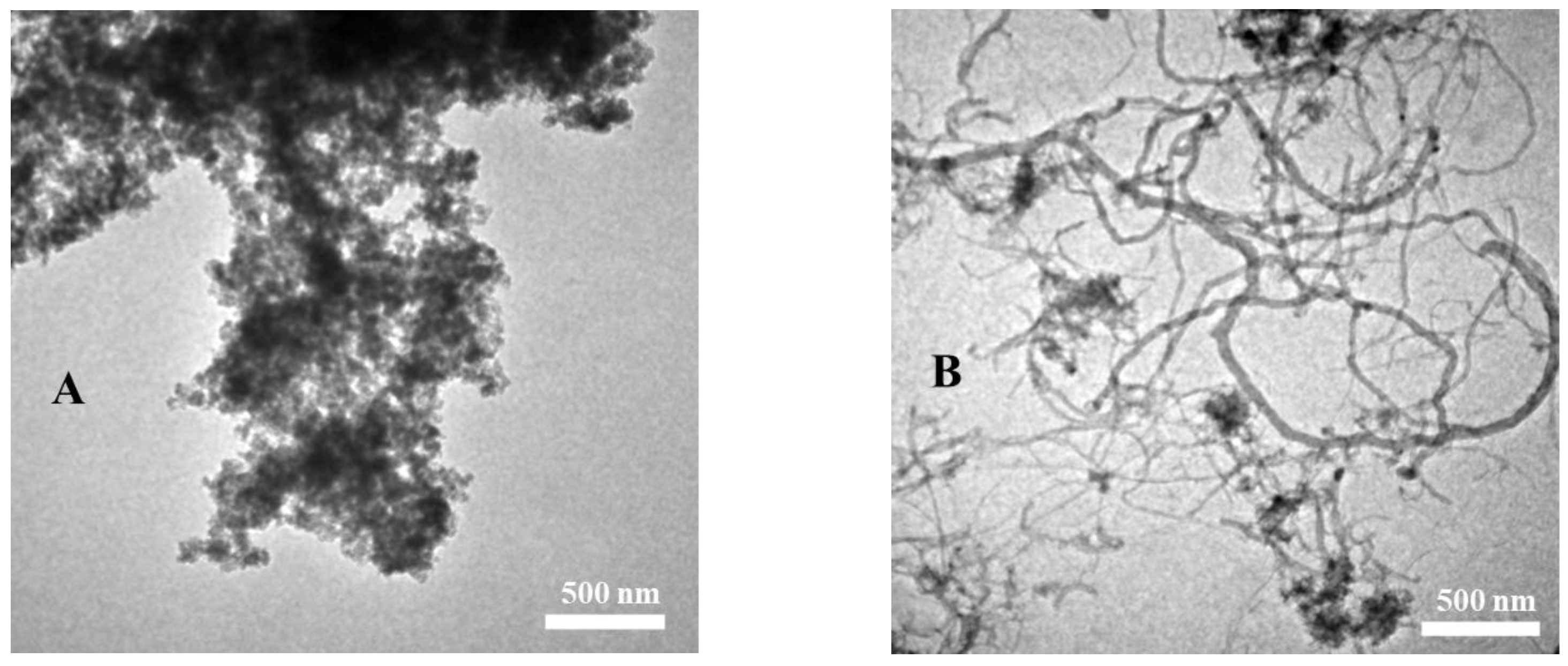

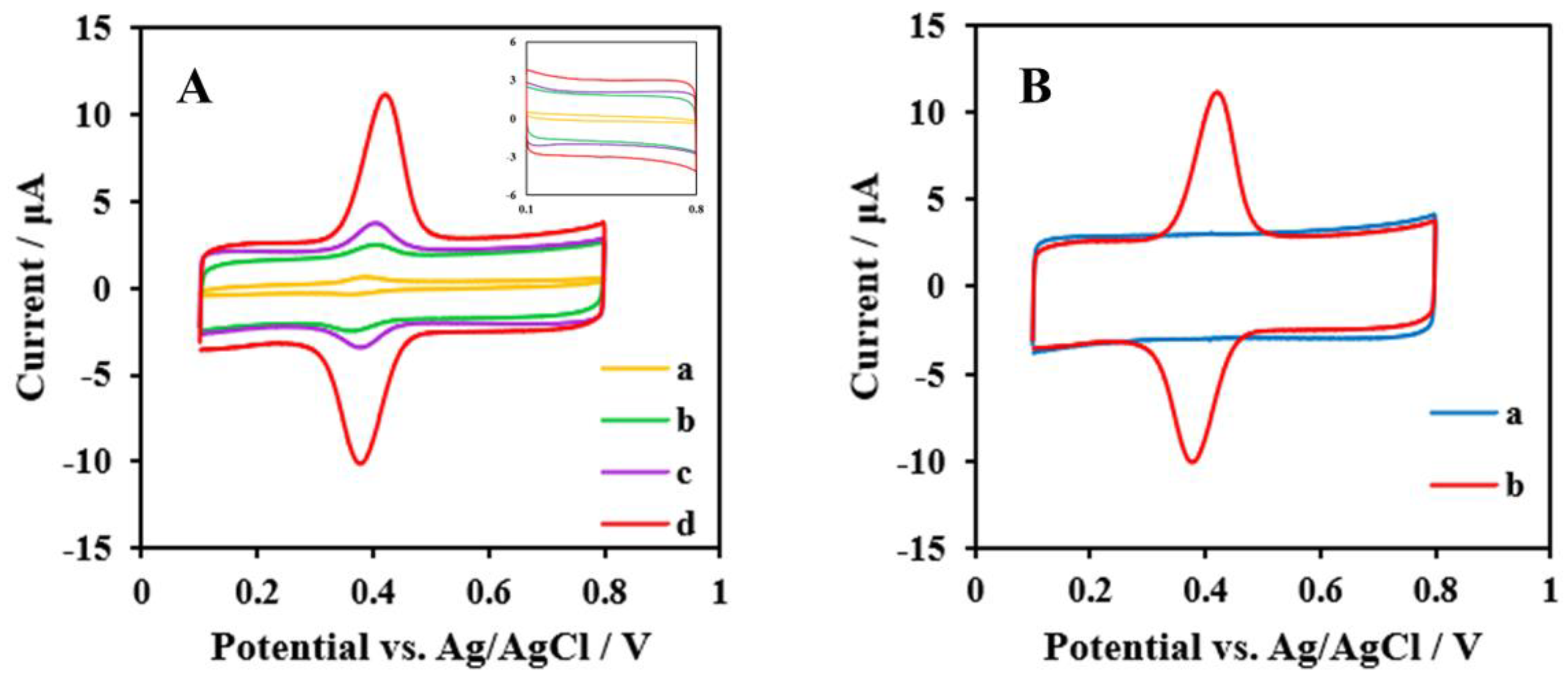

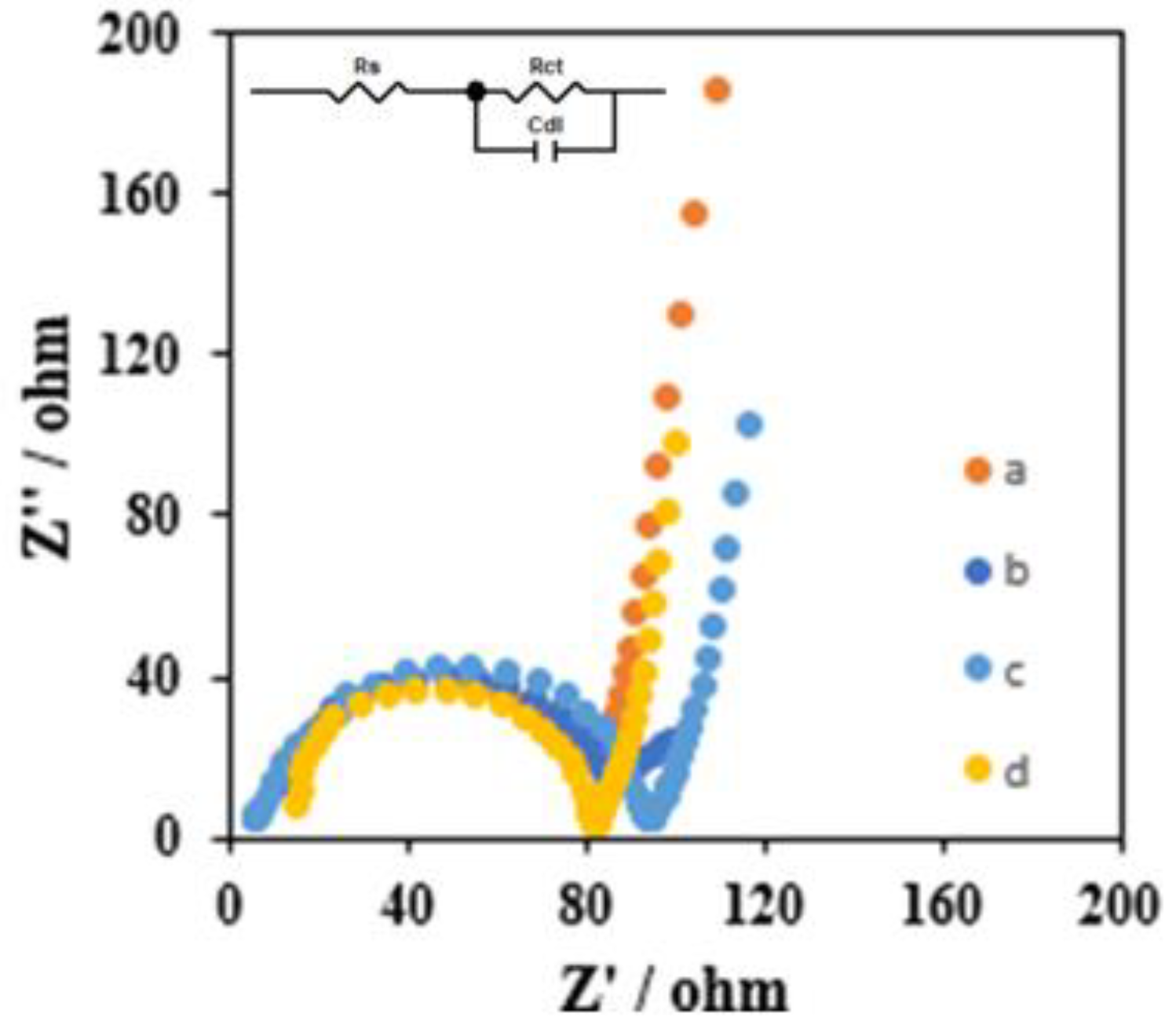
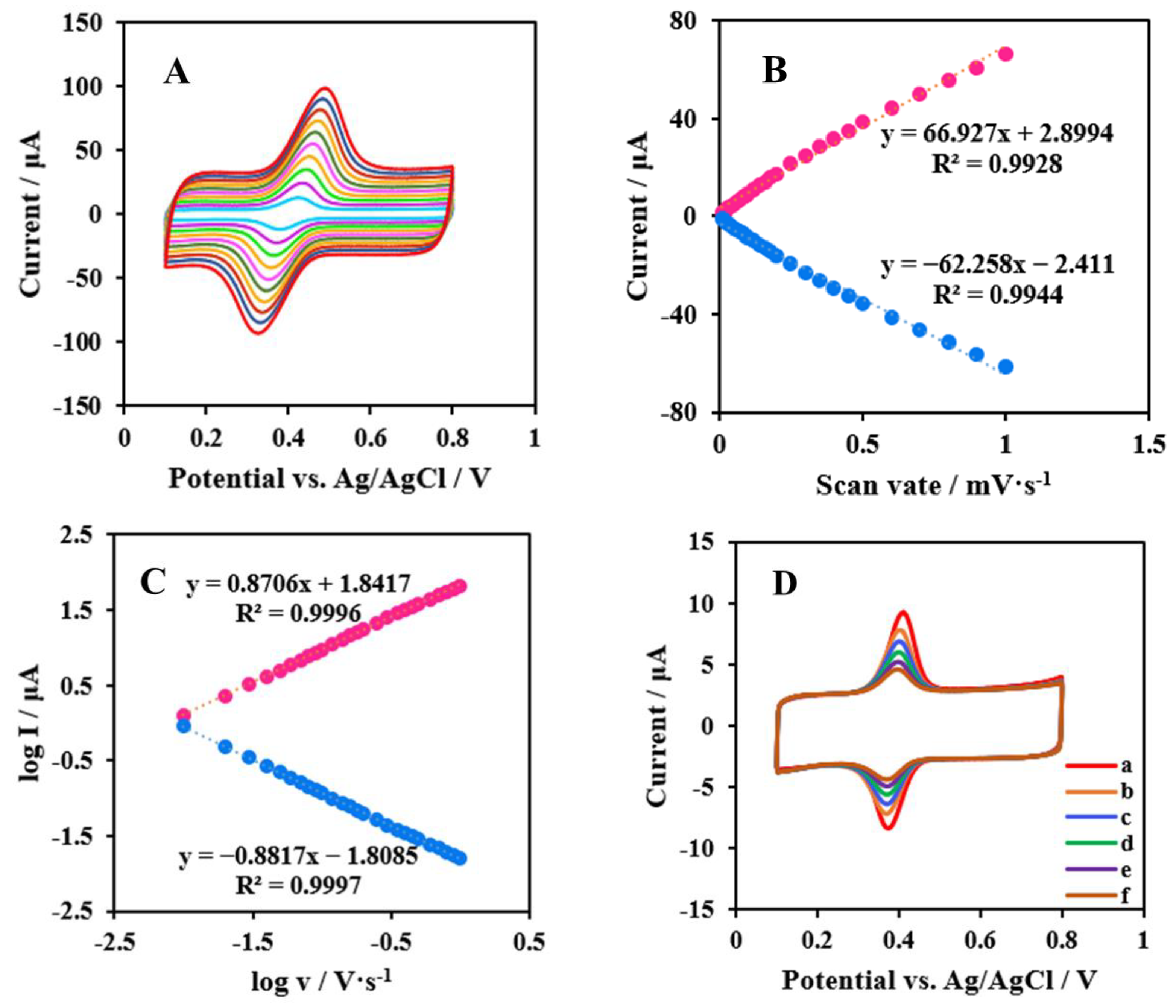
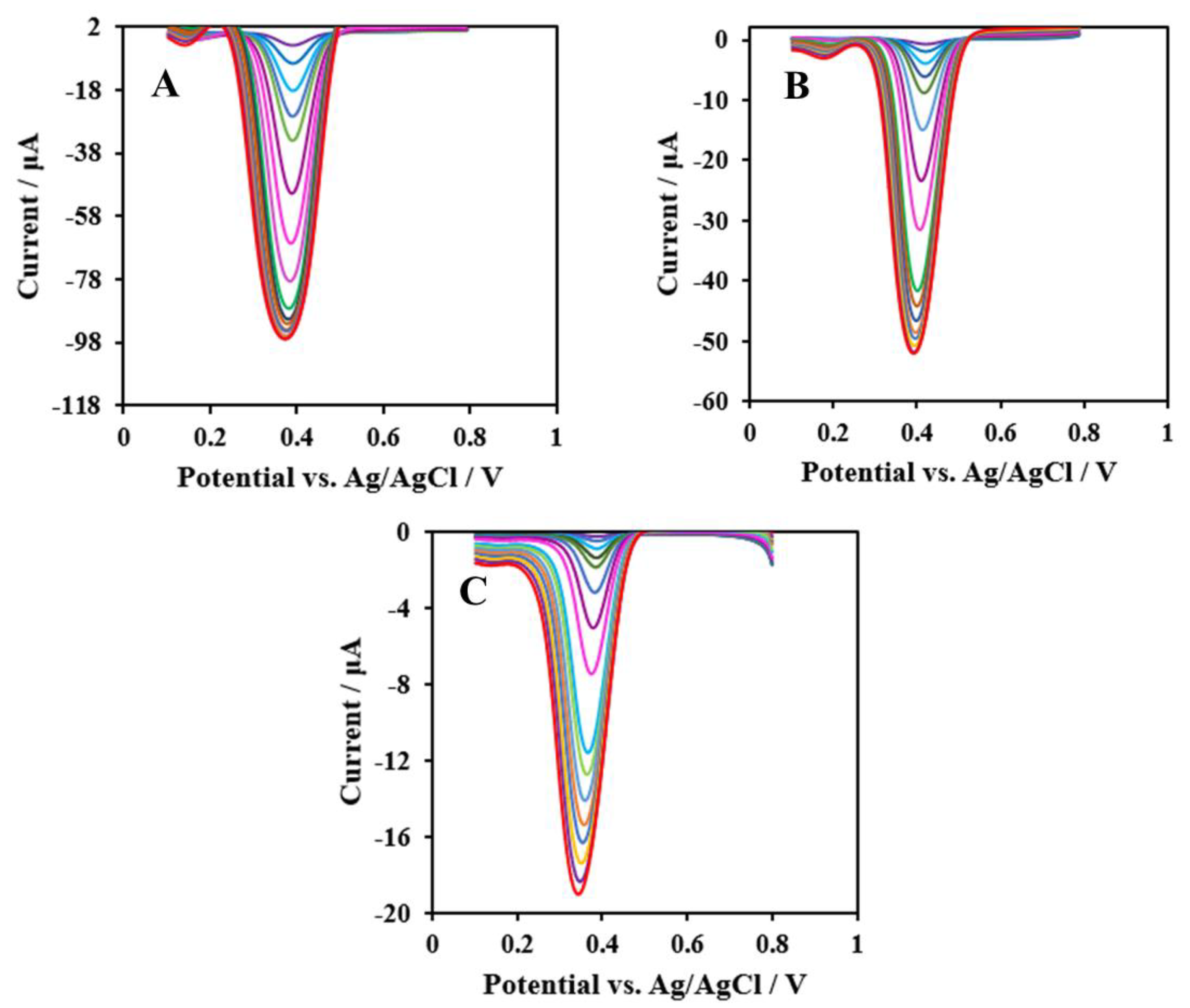

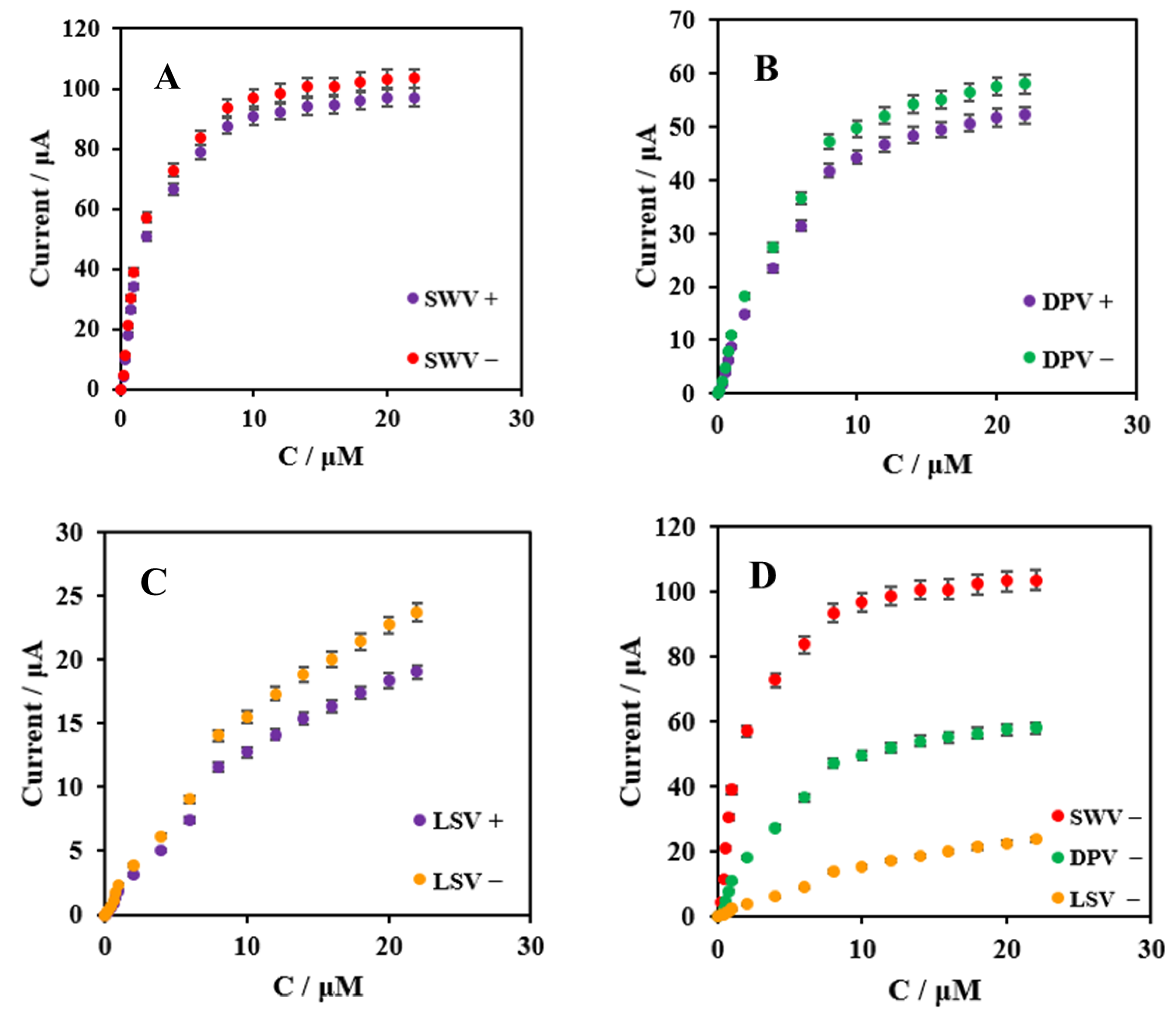
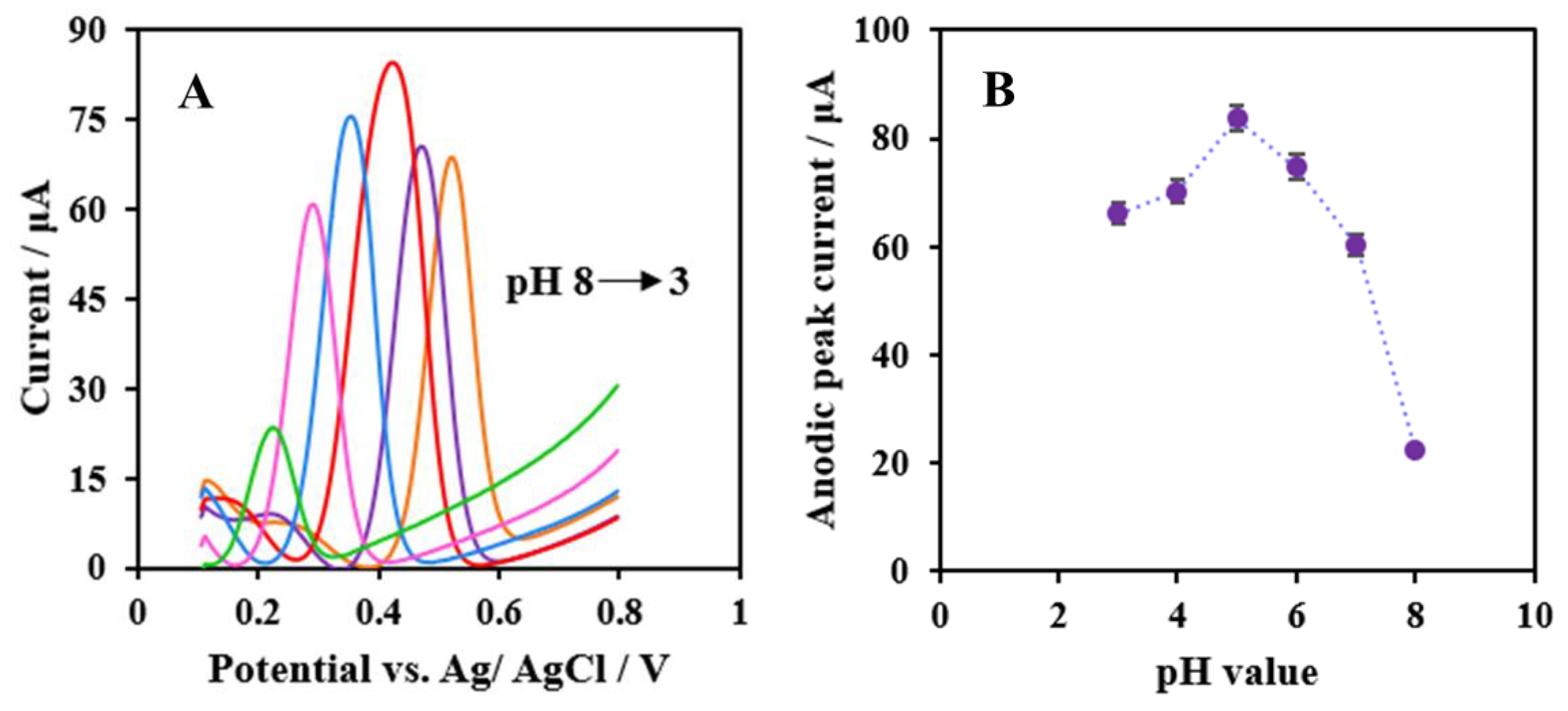
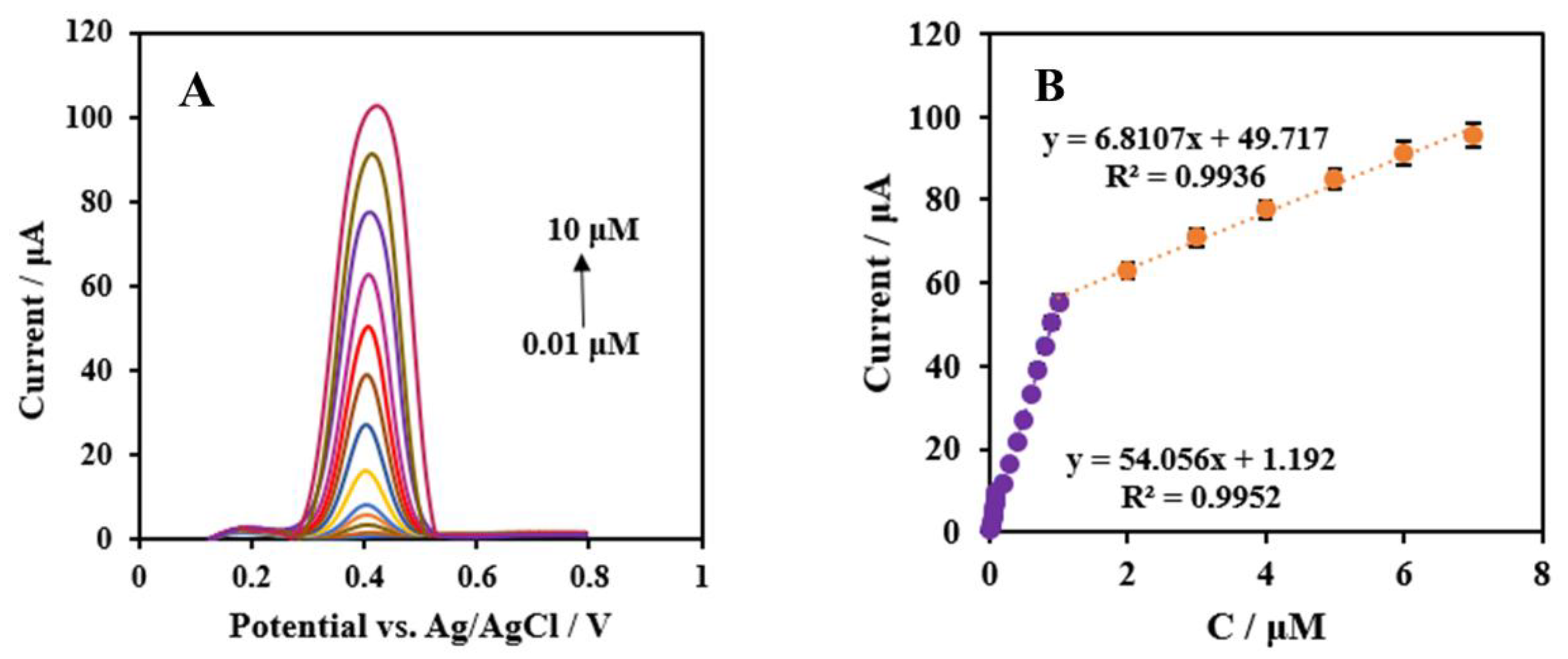
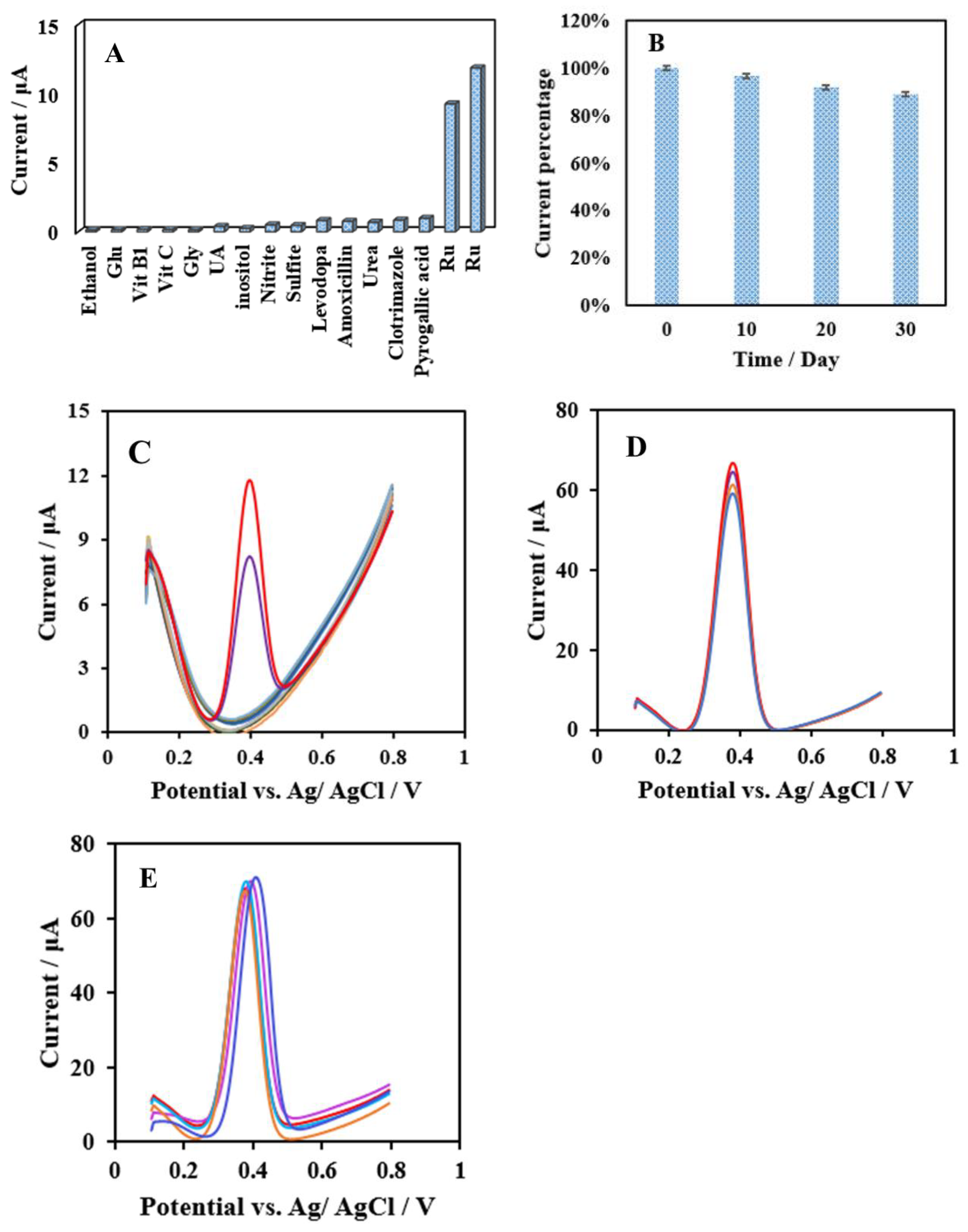
| Electrode | Method | Linear Range (μM) | LOD (μM) | Reference |
|---|---|---|---|---|
| MIP/MWCNTs/GCE | DPV | 0.4–10 | 0.11 | [4] |
| ZnO-rGO-PB/MCPE | DPV | 0.07–7, 7–100 | 0.02 | [15] |
| MWCNTs-IL-Gel/GCE | DPV | 0.072–6 | 0.02 | [33] |
| DMI·Tf2N-LAC/CPE | SWV | 5.84–53.6 | 0.69 | [36] |
| PtNPs/rGO/GCE | DPV | 0.057–102.59 | 0.02 | [57] |
| Pt@r-GO@MWCNTs/GCE | DPV | 0.05–50 | 0.005 | [58] |
| AuNPs-CD-LAC/CPE | SWV | 0.3–2.97 | 0.17 | [59] |
| Ni-GO/GCE | SWV | 0.011–1, 2.2–15 | 0.0032 | [60] |
| MWCNTs-CD-Fe3O4/GCE | DPV | 0.02–10 | 0.0164 | [56] |
| GO-CS/GCE | DPV | 0.9–90 | 0.56 | [61] |
| PVP/CPE | LSV | 0.39–13 | 0.15 | [62] |
| NF/IL/CMC-MWCNTs/GCE | SWV | 0.01–1, 1–10 | 0.0066 | This work |
| Samples | Concentration (μM) | UHPLC (μM) | Sensor (μM) | RSD (%) |
|---|---|---|---|---|
| 1 | 1 | 0.94 | 0.92 | 2.25 ± 0.02 |
| 5 | 4.70 | 4.68 | 1.93 ± 0.05 | |
| 10 | 9.60 | 9.72 | 1.23 ± 0.04 | |
| 2 | 1 | 0.78 | 0.81 | 1.41 ± 0.06 |
| 5 | 4.50 | 4.73 | 2.22 ± 0.04 | |
| 10 | 9.40 | 9.65 | 2.51 ± 0.03 |
Disclaimer/Publisher’s Note: The statements, opinions and data contained in all publications are solely those of the individual author(s) and contributor(s) and not of MDPI and/or the editor(s). MDPI and/or the editor(s) disclaim responsibility for any injury to people or property resulting from any ideas, methods, instructions or products referred to in the content. |
© 2023 by the authors. Licensee MDPI, Basel, Switzerland. This article is an open access article distributed under the terms and conditions of the Creative Commons Attribution (CC BY) license (https://creativecommons.org/licenses/by/4.0/).
Share and Cite
Meng, X.; Xiao, B.-L.; Song, X.-Y.; Ma, X.-X.; Li, Y.-Y.; Ma, L.-L.; Chen, Y.-J.; Li, Y.-Y.; Xu, K.-X.; Wei, J.-S.; et al. Highly Selective and Sensitive Sensor Based IL and CMC-MWCNTs Nanocomposite for Rutin Determination. Chemosensors 2023, 11, 171. https://doi.org/10.3390/chemosensors11030171
Meng X, Xiao B-L, Song X-Y, Ma X-X, Li Y-Y, Ma L-L, Chen Y-J, Li Y-Y, Xu K-X, Wei J-S, et al. Highly Selective and Sensitive Sensor Based IL and CMC-MWCNTs Nanocomposite for Rutin Determination. Chemosensors. 2023; 11(3):171. https://doi.org/10.3390/chemosensors11030171
Chicago/Turabian StyleMeng, Xin, Bao-Lin Xiao, Xin-Yan Song, Xin-Xin Ma, Yang-Yang Li, Lin-Lin Ma, Yu-Jie Chen, Yu-Ying Li, Ke-Xin Xu, Jian-She Wei, and et al. 2023. "Highly Selective and Sensitive Sensor Based IL and CMC-MWCNTs Nanocomposite for Rutin Determination" Chemosensors 11, no. 3: 171. https://doi.org/10.3390/chemosensors11030171
APA StyleMeng, X., Xiao, B.-L., Song, X.-Y., Ma, X.-X., Li, Y.-Y., Ma, L.-L., Chen, Y.-J., Li, Y.-Y., Xu, K.-X., Wei, J.-S., Hong, T., Moosavi-Movahedi, A. A., & Hong, J. (2023). Highly Selective and Sensitive Sensor Based IL and CMC-MWCNTs Nanocomposite for Rutin Determination. Chemosensors, 11(3), 171. https://doi.org/10.3390/chemosensors11030171









